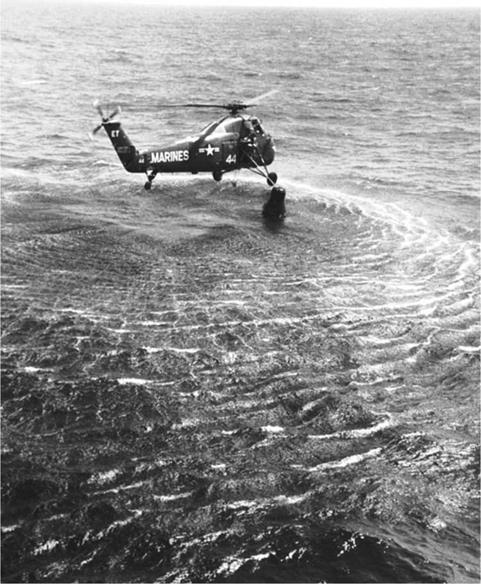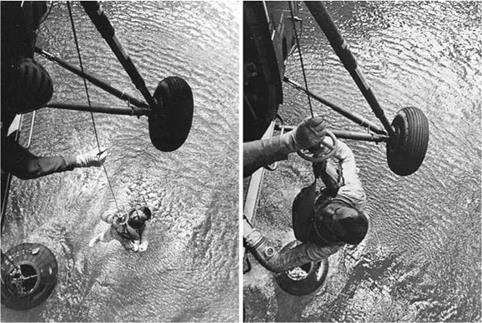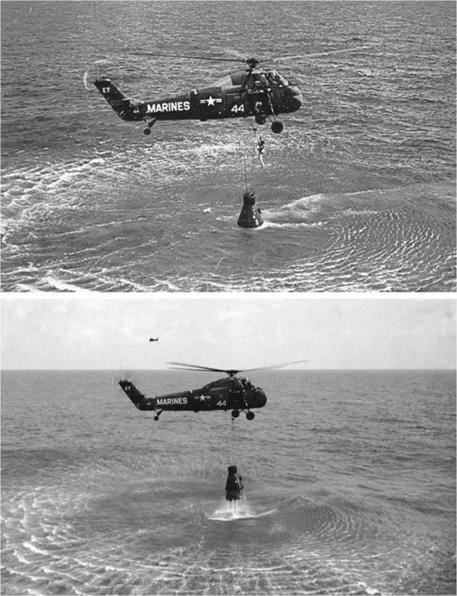RIGHT ON THE SPOT
Normally, the helicopter carried three crewmembers including a crew chief, but due to the expectedly high weight of the spacecraft the crew had been reduced to just the pilot and copilot. Wayne Koons revealed he could hear Shepard’s transmissions from about the time Freedom 7 reached 85,000 feet, when the astronaut came within range of their receiver. “And then we were actually talking with him after he had struck the water and was waiting to be picked up. We were right on the spot. We were waiting for [the capsule] to hit. We were circling the parachute as it came down.” [16]
At the time of splashdown, George Cox was at the flight controls with Koons. All seemed to go as expected once the capsule was in the water, so Cox left his cockpit seat and shinnied down below to make ready for the task of retrieving the astronaut and his vessel. First they had to verify that the parachute had been released from the bobbing craft by Shepard and had sunk beneath the surface, which, as Koons stated, was “something we always had to watch out for, because if there was any part of that chute above water, you ran the chance of the rotor wash picking it up and inflating it again. So we had to be sure it was off and sunk in the water so that it wasn’t going to come up.” [17]
Koons and Cox kept waiting for the spacecraft’s long HF antenna to pop up, but when they couldn’t see it Koons moved into position above Freedom 7. Ordinarily, one of Cox’s immediate duties would have been to lower a tool that had a bolt-cutter with explosive squibs at its end to sever the antenna to prevent it interfering with the raising of the astronaut into the helicopter. To his surprise, he found that the squibs were absent, but since the antenna had not deployed he re-stowed the antenna cutter. While Koons skillfully hovered above Freedom 7, Cox used the “shepherd’s hook” to snag the recovery loop on top of the spacecraft. At that point, without warning, the HF antenna telescoped upwards and its tip struck the helicopter’s fuselage.
According to the post-flight report which NASA declassified in June 1973, “The explosively actuated telescoping HF recovery antenna [was] erected after helicopter hook-onto the capsule but prior to pilot egress. The activation time was normal; the helicopter moved into recovery position earlier than planned. The helicopter pilot observed only a 10-foot length of the antenna rather than the normal 16 feet. Later inspection showed the last 6 feet had probably been blown off at erection. There was no evidence of this section striking the helicopter. The remaining 10-foot section was not cut off by the helicopter crew, and caused no difficulty in recovery.” [18]
Koons would later say that the recovery was otherwise a fairly routine operation. “The only anomaly we had, was that that antenna did pop up sometime. I’m not sure when it did, but we found a dent in the bottom of our helicopter…. But I never knew when that happened, when it finally decided to go.” [19]

|
Charles Tynan, the senior NASA representative present, told the author about the missing explosive squibs. “The squibs were for the tool the helicopter crewman was to use to cut off the HF antenna, because it was long enough to contact the helicopter rotors. The Marine helicopter mechanic’s tool box was broken into the night before the recovery and all the pyrotechnic squibs were stolen. There was plenty of time for more squibs to be flown out to the carrier from the Cape, but the Captain would not let this happen because he didn’t want the bad publicity for his command.” [20]
When everything was ready, Cox prepared to hoist Shepard up into the helicopter. “I was in the belly of the aircraft and operated the hoist [which] took him from the capsule up to the cabin of the helicopter. [We] hooked onto the capsule and started pulling it up to steady it upright in the water. We told Commander Shepard we were ready for him to come out and recover him, and he asked us to raise the capsule a little bit higher.” [21] Shepard later said this was because he could still see water out of a porthole and wanted to avoid getting any of it inside the spacecraft. “I’m not sure he heard me at first, but I was able to get through to him that I’d be coming out as soon as he lifted the door [hatch] clear of the water.” For this first flight of the Mercury spacecraft, Freedom 7 possessed a mechanical hatch which was fitted with latches that were to be actuated by a handle that Shepard would crank. But first Shepard had to attach a metal cable to the hatch in order to prevent it from being lost once free. “I called the helo and told him I was ready to come out, and he verified that he was pulling me up. I told him I was powering down and disconnecting communications.” [22]
Koons obliged the request by raising the capsule a foot or two higher. “We were all very aware that the spacecraft hatch was normally partially below the waterline,” he says. “We knew for sure that opening the hatch too soon would result in flooding the spacecraft, so Shepard’s request to raise the spacecraft higher was redundant in that we were in the process of doing just that.” [23]
Shepard now said he would be out in about 30 seconds. By pre-arrangement, if he had decided at this point not to exit the capsule then Koons would have hoisted it out of the water and transported him to the carrier inside the spacecraft. Having opted to egress, all Shepard had to do was to rotate the locking handle so that the hatch would detach and then scramble out.
“The door was ready to go off. I disconnected the biomedical packs. I undid my lap belt, disconnected the communications lead, and opened the door.” As the hatch opened Shepard allowed it to fall away. Unfortunately, even though he had properly affixed the hatch to the capsule by the cable, the crimped metal clip on the lower end of the cable had been closed over the plastic sheath instead of over the cable, and this allowed the cable to pull out. The unrestrained hatch plunged into the water and sank to the ocean floor.
As Shepard later said, he climbed out “and very easily worked my way up into a sitting position on the door sill. Just prior to doing this, I took my helmet off and laid it over in the position in the… as a matter of fact, I put it over the hand controller.” [24] He began looking upwards for the “horse collar” recovery harness, which Cox was in the process of lowering to him.
“It went like another practice run,” Cox pointed out later. “In just a moment we began the hoist. He was giving me a big grin all the way up, and a big thumbs-up. He looked like the same Commander Shepard that I’d known before and worked with,
|
Lt. George Cox winches Alan Shepard into the helicopter. (Photos courtesy of Dean Conger/ NASA) |
except a little happier than before.” [25] As he ascended, Shepard brushed up against the truncated antenna, but it was flexible and no harm was done.
As requested, Koons had reminded Cox to turn on photographer Dean Conger’s camera before hoisting the astronaut, and received confirmation this had been done. “Well, that’s what wound up on the cover of Life magazine,” he would later reflect. “You can see the back of George Cox’s head and Shepard coming. You can’t really tell whether he’s smiling or not, but he was almost in the helicopter and was pretty happy about that.” [26]
Perched precariously on the sill of the capsule’s hatch, Shepard had waited a few moments before grabbing the “horse collar,” which dunked in the water before being lifted clear. “I grabbed it and got into it with very little difficulty. Shortly thereafter I was lifted directly from a sitting position out of the capsule up toward the chopper. The only thing that gave me any problem at all, and it was only a minor one, was that I banged into the HF antenna, but of course it is so flexible it didn’t give me any trouble.” [27] Koons later reflected that the calm sea was ideal for the recovery, which went just as in training. “Within two minutes of the time [Freedom 7] hit the water we had the commander out of his capsule and in our craft.” [28]
As Dean Conger recalls, the remarkable photographs of Shepard’s retrieval which would grace many magazine covers almost didn’t happen. “The antenna was broken off either before or after [ocean] impact. So the prepared plan was ditched and in the excitement of the event the copilot forgot about the switch for the camera and they began all the other recovery procedures. Fortunately, he remembered at the very last minute.
There were about 10 frames of Shepard coming up, and 230 frames of just the capsule and water after he was in the chopper! Doesn’t matter. It was enough. Marine Lt. George Cox should get much of the credit for the success of the photos. The same bracket was used on subsequent flights but never produced a publishable photograph.” [29]
|
In the top photograph, Shepard can be seen ascending to the hovering helicopter. At bottom, with the astronaut safely on board, the helicopter hoists Freedom 7 from the sea and water streams out of the deployed landing bag. (Photos: U. S. Navy) |
Once on board the helicopter, Shepard shook Cox’s hand before being directed to a bucket seat. All members of the recovery crews had been given strict instructions not to speak to the astronaut unless he spoke to them first. Understandably, doctors and psychologists desired him to tell his story to them without it being colored by impressions conveyed to him during his return. “We were instructed not to direct our conversation to him,” Cox explains, “but if he spoke to us we could answer him and talk to him if he started it. I pointed him toward his seat, to sit down for the ride back to the carrier.” [30] Before he took his seat, however, Shepard looked out and said with consummate gratitude, “What a beautiful day!” Meanwhile, Cox and Koons attended to retrieving Freedom 7 from the water.
As Shepard later recorded, “I sank into a bucket seat as soon as I reached the top, and on the way to the carrier I felt relieved and happy. I knew I’d done a pretty good job. The Mercury flight systems had worked out even better than we’d thought they would. And we’d put on a good demonstration of our capability right out in the open where the whole world could watch us taking our chances.” [31]












